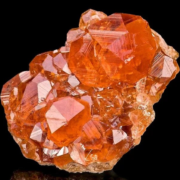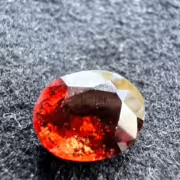hessonite – properties, virtues & benefits
Hessonite stone, also known as honey-colored garnet, is a popular gemstone for its warm colors and sPiritual significance. Discover the unique characteristics and uses of this gemstone in our guide.
HESSONITE CHARACTERISTICS
- Chakra: Solar plexus and root.
- Properties: Protection, purification, energy, creativity, healing, sPirituality.
- Astrology: JuPiter.
- Zodiac: Leo.
- Elements: Earth and fire.
- Colors: Yellow, orange, reddish brown.
- Hardness: 6.5-7.5 on the Mohs scale.
- Chemical Formula: Ca3Al2(SiO4)3.
- Associated god: Demeter (Greek goddess of agriculture and fertility).
HESSONITE STONE – HIS HISTORY
Hessonite stone is a type of garnet that belongs to a family of crystalline minerals with a variety of colors. Although red is the best-known color, garnets are available in almost every color except blue. The name “garnet” comes from the Latin word “granatus”, meaning “with grains”, perhaps in reference to the pomegranate, a fruit whose seeds resemble the shape, size and color of this rock.
Garnets are available in different colors, and each color has a different name for the stone Hessonite. For example, pyrope is fiery red, rhodolite is Pinkish red, almandine is brick red, spessartine is orange to reddish brown, hessonite is deep orange, tsavorite is intense green and demantoid is meadow green to emerald. Garnets are common gems in brown, red, green, yellow, black and colorless.
Hessonite is a fine stone of great historical importance. It is more common than ruby or sapphire and is used for purposes other than ornamentation. Because of its resistance, it was used in the past to engrave other stones such as agate or jasper. It was also used to create an abrasive powder for polishing and roughening these stones. Today, it is still used for precision waterjet cutting and for gluing on sandpaper.
Hessonite is a rock whose first evidence of use dates back to the Bronze Age, notably in Czechoslovakia, where Pyrope was mined. It was also widely used in ancient Egypt for pharaohs’ finery and was dedicated to Sekhmet, the goddess of war. Other examples of its use date back to the Sumerians around 2100 BC, to the ancient Greeks who believed it made them nyctalope, to the Romans who referred to it as almandin carbunculus because of its color, and to the Celts who used it in their weapons and jewelry to grant themselves protection and courage. The Hebrew Talmud recounts that the rock was used to light Noah’s ark, and in the Bible, a Hessonite stone was found on Aaron’s breastplate. Today, it is still used for precision cutting and as an abrasive for sanding.
During the Middle Ages, Hessonite was thought to increase constancy and faith, and ward off melancholy. Crusaders wore it to give themselves courage in battle and faith in their enterprise, and it was used as a remedy for plague and tissue damage. Arab rulers also wore it, believing it to symbolize sincerity. Among Native American tribes, rock was used to decorate shields, make jewelry and adorn dreamcatchers, enabling Native Americans to show what was invisible. In some Asian traditions, rock is associated with blood because of its color, and was used as a projectile in battle. It was also used as an amulet in India and the Far East, to protect against plague and poison and attract health and hapPiness. Hessonity is considered a protective stone symbolizing fidelity and truth, and is traditionally associated with January births by jewelers.
HESSONITE STONE – ITS ORIGIN AND COMPOSITION
Hessonite is a beige, brown or orange-colored rock that comes from grossularite, an aluminous calcium mineral belonging to the Ugrandite family, which is part of the Garnets. The Ugrandite series also includes Uvarovite and Andradite, as well as intermediate and/or differently-colored varieties such as Tsavorite, Rosolite, Leucogrenat and Hydrogrossulaire. The name Hessonite comes from the Greek “hesson” meaning “less” or “inferior”, in reference to its lower hardness and density than most other members of its family. It has also been called Cinnamon Stone due to the presence of iron impurities that give it its color, ranging from dark brown to light orange depending on the amount of ferrous and ferric iron.
The finest specimens are found in Asbestos in Canada, Kataragama and OkkamPitiya in Sri Lanka, Jharkhand in India, Maevatanana in Madagascar, Lelatema in Tanzania and Balistan in Pakistan. Although it is often cloudy or translucent due to numerous evenly distributed micro-inclusions, some specimens are perfectly transparent and light or orange in color, making them higher-grade rocks, more expensive and sought-after by collectors and designer-jewelers. However, it can be imitated by other rocks of lesser value, such as certain Smoky Quartz or Smoky Citrines, as well as by artificial or synthetic rocks such as glass, YAG, GGG or cubic zirconium oxide.
To avoid disappointment, we recommend buying Hessonite from a reputable jeweler or gemological dealer.

HESSONITE STONE – VERTIES AND PROPERTIES
HESSONITE ON THE PSYCHOLOGICAL LEVEL
Hessonite stone is an anchoring rock that is both visually radiant and energetically reassuring. It is particularly useful for people seeking to reconnect with their physical body, as well as for those wishing to develop the qualities associated with a balanced sacral chakra, such as creativity, pleasure and joie de vivre. This rock facilitates the balancing of the second chakra by encouraging letting go, while decreasing mental control and promoting spontaneity and creativity.
It is also known for its benefits on energy and vitality, as well as for helPing to undertake projects with courage and determination. It stimulates the survival instinct while reducing nervousness, but is not suitable for people who are already nervous or hot-tempered, as it can aggravate these personality traits. In addition, this rock can be used to enhance experiences such as hypnotic regression and reduce taboos and inhibitions.
In terms of protection, Hessonite is considered a powerful stone that enables its wearer to face conflicts and enemies thanks to the mental peace it provides. It also attracts money and prosperity, and promotes success and hapPiness in general. In short, Hessonite is an anchoring stone that can help reduce negative energies and promote energetic balance.
HESSONITE ON THE PHYSICAL LEVEL
On the physical level, Hessonite stone promotes fulfillment and allows the body to find its place again. It can help release old emotional and physical wounds. In lithotherapy, this stone is known to regulate blood pressure and promote good blood circulation in the body. It is also a sexual stimulant, particularly for men.
Hessonite stone is also useful for the sacral chakra, which can help combat sleep problems and hypersensitivity.

HESSONITE STONE – CLEAN AND RECHARGE
Hessonite stone is a natural gem that can absorb surrounding energies, which can affect its effectiveness and potency. So it’s important to regularly cleanse and recharge your hessonite stone to ensure it remains effective. Here are a few methods for cleaning and recharging your hessonite stone:
Cleaning:
- Distilled water: You can clean your hessonite stone by rinsing it in distilled water for a few minutes. Avoid tap water, as it may contain harmful chemicals that can damage the stone.
- Salt: You can also clean your hessonite stone by placing it on a bed of salt for a few hours. Be sure not to use wet salt, as this could damage the stone.
Loading:
- Solar light: The hessonite stone can be recharged by placing it under direct sunlight for a few hours.
- Moonlight: You can also recharge your hessonite stone by placing it under the light of a full moon overnight.
- Crystals: You can recharge your hessonite stone by placing it on a cluster of quartz or amethyst crystals for a few hours.
It is recommended to clean and recharge your hessonite stone every month or when you feel it has lost its effectiveness.
WHERE DOES THE NAME HESSONITE COME FROM?
The name “hessonite” comes from the Greek word “hesson”, meaning “smaller” or “smaller in number”. This name was given to this stone because of its relatively small size compared with other types of garnet. The scientific name for hessonite stone is “grossular”, which is derived from the Latin word “grossularia”, meaning “gooseberry”. This refers to the reddish-orange color of some specimens of this stone, which resembles that of currants. Hessonite stone is also known by other names, such as Ceylon garnet or fluted garnet due to its characteristic striated texture.
WHICH CHAKRA DOES HESSONITE ACT ON?
Hessonite stone is associated with two main chakras, the solar plexus chakra (third chakra) and the root chakra (first chakra). The solar plexus chakra is located in the abdomen and is associated with self-confidence, personal power, self-esteem and creativity. When the solar plexus chakra is out of balance, it can cause digestion problems, eating disorders, sleep problems, muscle and joint pain, as well as skin problems.
The root chakra is located at the base of the sPine and is associated with stability, security, self-confidence and connection to the earth. When the root chakra is out of balance, it can cause anxiety, stress, fear, fatigue, sleep problems, as well as back and leg problems.
Hessonite stone can help balance these two chakras by providing stable earth energy and stimulating self-confidence and creativity. It can also help relieve digestive problems, muscle and joint pain, and skin problems associated with an imbalance in the solar plexus chakra.
WHICH ASTROLOGICAL SIGN IS ASSOCIATED WITH HESSONITE?
Hessonite is traditionally associated with the astrological sign Leo. Leo is a fire sign that is ruled by the Sun, and is associated with creativity, passion, self-confidence, optimism and generosity. People born under the sign of Leo can benefit from hessonite’s energy to boost their self-confidence, creativity and passion. It can also help balance emotions and relieve the stress and anxiety associated with this astrological sign. However, it’s important to note that each person is unique and the stone’s energy can have a different effect on each individual, regardless of their zodiac sign.
HESSONITE STONE SUMMARY
Hessonite stone, also known as grossular garnet, is a gemstone belonging to the garnet family. It is generally orange-brown to red-brown in color and is mined mainly in India, Sri Lanka, Tanzania and Brazil.
Hessonite stone is considered to have healing and sPiritual properties, including the ability to help improve digestion and blood circulation, as well as promoting concentration and creativity. It is also considered a stone of protection and healing for the root chakra.
In jewelry, the hessonite stone is often used to create rings, pendants and earrings. It is also often used as a birthstone for people born in January.



